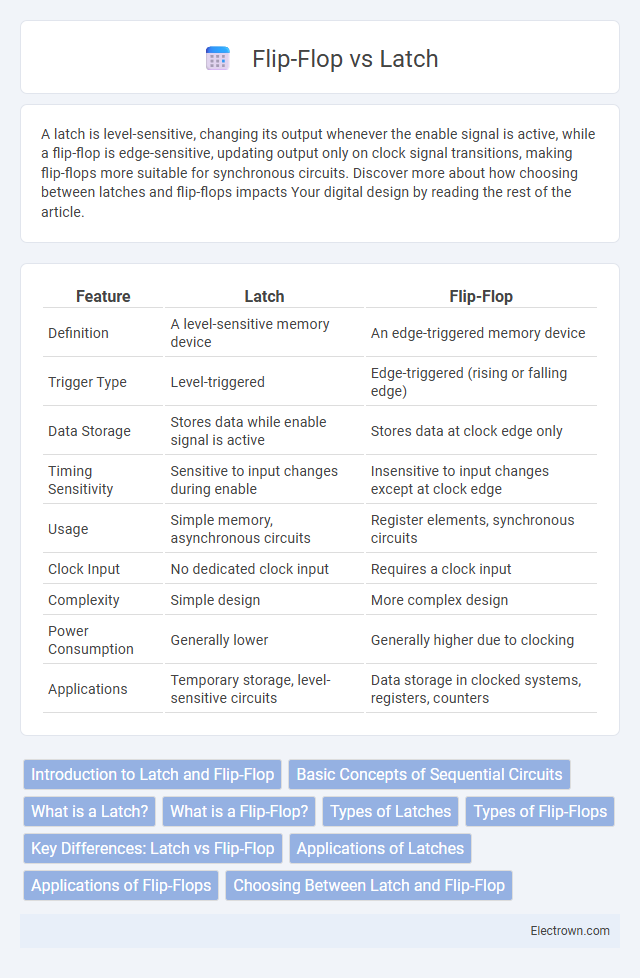A latch is level-sensitive, changing its output whenever the enable signal is active, while a flip-flop is edge-sensitive, updating output only on clock signal transitions, making flip-flops more suitable for synchronous circuits. Discover more about how choosing between latches and flip-flops impacts Your digital design by reading the rest of the article.
Table of Comparison
| Feature | Latch | Flip-Flop |
|---|---|---|
| Definition | A level-sensitive memory device | An edge-triggered memory device |
| Trigger Type | Level-triggered | Edge-triggered (rising or falling edge) |
| Data Storage | Stores data while enable signal is active | Stores data at clock edge only |
| Timing Sensitivity | Sensitive to input changes during enable | Insensitive to input changes except at clock edge |
| Usage | Simple memory, asynchronous circuits | Register elements, synchronous circuits |
| Clock Input | No dedicated clock input | Requires a clock input |
| Complexity | Simple design | More complex design |
| Power Consumption | Generally lower | Generally higher due to clocking |
| Applications | Temporary storage, level-sensitive circuits | Data storage in clocked systems, registers, counters |
Introduction to Latch and Flip-Flop
Latches and flip-flops are fundamental memory elements in digital circuits used for storing binary information. A latch is a level-sensitive device that changes its state based on the input signal level, whereas a flip-flop is edge-triggered, capturing data on a specific clock edge. Understanding the differences in timing and control mechanisms helps optimize your digital design for stability and performance.
Basic Concepts of Sequential Circuits
Sequential circuits rely on memory elements like latches and flip-flops to store and control data states over time. Latches are level-sensitive devices that change output based on input signal levels, while flip-flops are edge-triggered, capturing data only at specific clock transitions. Your choice between latch and flip-flop impacts timing precision and synchronization in digital system design.
What is a Latch?
A latch is a basic memory device in digital electronics that stores one bit of information by maintaining a stable state when enabled by a control signal. It operates asynchronously, meaning it changes its output immediately in response to input changes as long as the enable signal is active. Unlike flip-flops, latches do not rely on clock edges to trigger state changes, making them simpler but prone to timing-related glitches.
What is a Flip-Flop?
A flip-flop is a fundamental bistable memory element in digital electronics that stores one bit of data by maintaining a stable state until triggered to switch. It operates on clock pulses, enabling synchronized data storage and transfer in sequential circuits like registers and counters. Flip-flops exhibit edge-triggered behavior, providing precise control over timing and reducing the chances of race conditions compared to latches.
Types of Latches
Latches are classified into several types, including SR (Set-Reset), D (Data or Delay), and JK latches, each serving specific roles in memory storage and signal control. The SR latch uses basic input signals to set or reset the output, while the D latch captures the input data on a control signal, making it ideal for temporary data storage. Understanding these types helps you choose the right latch for timing-sensitive applications compared to flip-flops, which operate synchronously with clock signals.
Types of Flip-Flops
Flip-flops come in several types, including SR, D, JK, and T, each designed for specific logic control and data storage purposes. The D flip-flop captures the input value at a clock edge and is widely used for data synchronization, while the JK flip-flop can toggle states based on input combinations, making it versatile for counters and shift registers. Understanding these types helps you choose the right flip-flop for your digital circuit design, optimizing performance and functionality.
Key Differences: Latch vs Flip-Flop
Latches are level-sensitive devices that change output based on the input signal's level, whereas flip-flops are edge-triggered and update output only on specific clock edges, providing better timing control. Latches generally operate asynchronously and can lead to timing hazards, while flip-flops are synchronous, ensuring more precise data storage in digital circuits. Your choice between latch and flip-flop depends on the required timing accuracy and circuit design complexity.
Applications of Latches
Latches are widely used in asynchronous circuits, temporary data storage, and debounce circuits due to their ability to hold a state until changed by input signals. In scenarios requiring level-sensitive storage, such as edge-triggered flip-flops emulating, latches provide efficient timing and control in digital systems. Your choice of latches is ideal for applications needing immediate response to input changes without waiting for clock edges.
Applications of Flip-Flops
Flip-flops are fundamental components in digital circuits used for data storage, synchronization, and state retention in sequential logic designs. They serve critical roles in registers, counters, memory units, and digital communication systems where precise timing control and edge-triggered data capture are essential. Flip-flops facilitate clocked operations, making them indispensable in microprocessors, finite state machines, and timing-sensitive applications.
Choosing Between Latch and Flip-Flop
Choosing between a latch and a flip-flop depends on your circuit's timing requirements and complexity. Latches, being level-sensitive, are suitable for simpler designs where transparency during a clock level is acceptable, while flip-flops offer edge-triggered control, ensuring precise data synchronization in sequential logic. Your design benefits from flip-flops when strict timing and edge-based control are essential, whereas latches can optimize speed and power in less critical timing scenarios.
Latch vs Flip-Flop Infographic

 electrown.com
electrown.com